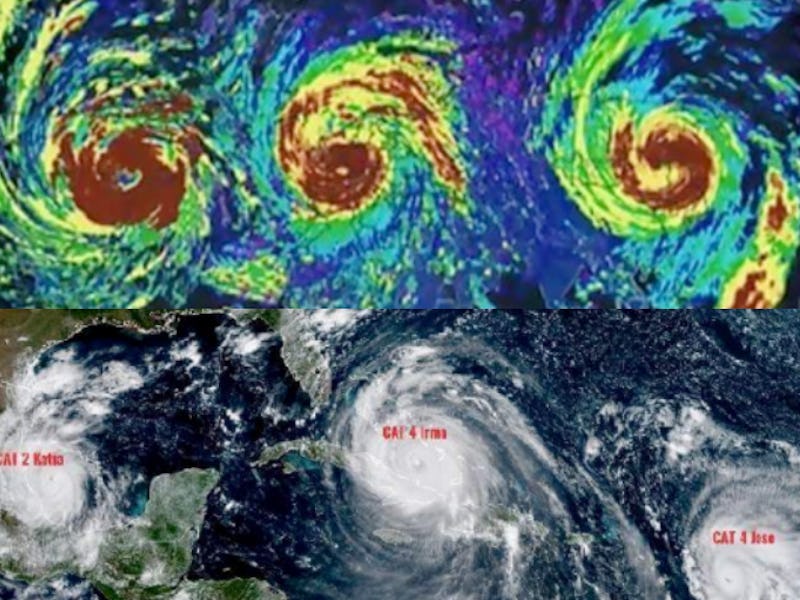For fans of the 2004 Dennis Quaid disaster film The Day After Tomorrow, watching news coverage of Hurricanes Irma, Jose, and Katia over the past few days has been triggering. A meme currently circulating the internet puts a map of the film’s hurricanes next to a map of the storms currently raging in the American southeast, pointing out their eerie similarities. At first glance, you might even be tempted to conclude the film was prophetic.
That is, until you realize that the film’s graphic shows the hurricanes swirling on top of a map showing the entire world, which just doesn’t make any sense.
The feeble premise of The Day After Tomorrow is that an “international storm” suddenly descends on the entire Earth after the North Atlantic Ocean’s circulation somehow gets disrupted by climate change. All three of the superstorms within the system form in the northern hemisphere, above Canada, Scotland, and Siberia, as the scary and very unrealistic map below shows.
Canada, Scotland, Siberia: all screwed!
These superstorms are so huge and so cold that they cause flash freezing across the globe, putting Earth on the brink of a new ice age. All the while, Quaid’s paleoclimatologist tries to save his son in New York City, and in the end, he succeeds. The movie’s depiction of science, of course, doesn’t. (It was duly panned by critics.)
If we’ve learned anything about hurricane formation from Harvey and Irma, it’s that storms always form above an ocean, and they lose steam as they move toward land. That’s because hurricanes must be powered by warm, moist air, which requires a warm ocean and strong winds to form, explains the NOAA. As the winds pass along the sea’s warm surface, they force the water to evaporate. That water vapor rises and cools, eventually turning into the cumulonimbus clouds that carry a hurricane’s heavy rains.
While hurricanes can certainly move toward land, it seems unrealistic to think that these huge storms could sustain themselves with such ferocity over large land masses (Scotland, maybe). Also, as paleontologist Jim Lehane, Ph.D., explains in his review of the film’s bad science, it’s impossible for it to be raining everywhere on the Earth because the “atmosphere needs to counterbalance itself.” Because of extreme differences between the temperatures of water and land caused by the positioning of the Earth’s continents and seas, a global superstorm made up of mini storms is simply “impossible.”
What is very possible, however, is for three (relatively smaller) storms to form in the same region of the ocean, as Irma, Jose, and Katia recently demonstrated, and many scientists warn that similar situations will only become more common as climate change continues to cause the oceans to warm. The Day After Tomorrow may have pushed the limits of storm formation past all semblance of reality, but it deserves some credit for bringing attention to the global scale of climate change and its effects.
Hurricanes Jose and Katia formed in the same region as Irma.
